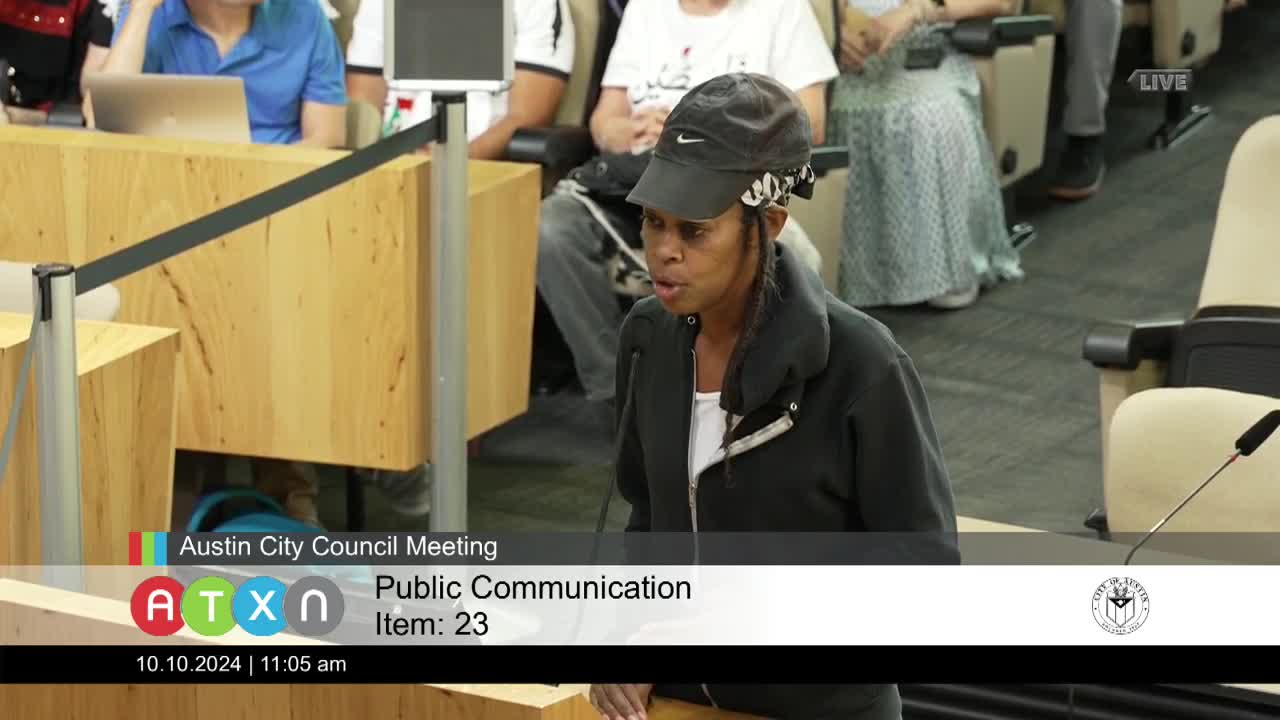Activists demand action on racial disparities in homelessness
October 10, 2024 | Austin, Travis County, Texas
This article was created by AI summarizing key points discussed. AI makes mistakes, so for full details and context, please refer to the video of the full meeting. Please report any errors so we can fix them. Report an error »

During a recent city council meeting, pressing issues surrounding homelessness and urban infrastructure were brought to the forefront by community members and advocates.
One poignant testimony came from a local resident who highlighted the stark reality of homelessness among African Americans, citing a report that indicates they are six times more likely to experience homelessness than their white counterparts. The speaker urged city officials to reconsider their housing strategies, emphasizing that current proposals do not adequately address the needs of marginalized communities. They criticized the allocation of funds for projects that do not prioritize eviction prevention or homelessness solutions, calling for a more inclusive approach to urban planning.
In contrast, discussions around the City Leap initiative showcased a vision for transforming Austin's streets to better accommodate non-car transportation. Advocates, including parents and local nonprofit leaders, expressed strong support for the initiative, which aims to create safer streets for children and promote biking and public transit. Testimonies underscored the importance of designing urban spaces with children in mind, as traffic fatalities and respiratory illnesses are significant concerns for families living near busy roadways.
Supporters of City Leap argued that the plan would not only enhance safety but also improve air quality and support local businesses. They pointed to successful examples of road lane conversions that have led to safer and more pleasant urban environments. The initiative is seen as a crucial step in addressing the city's growing traffic and congestion issues while promoting equity and sustainability.
Additionally, the council heard concerns regarding the Waller Creek design plan, with some community members questioning the necessity of extensive development and spending in the area. They called for a reevaluation of the project to ensure it aligns with the community's needs and preserves natural spaces.
As the meeting progressed, it became clear that the council faces significant challenges in balancing development with the urgent needs of vulnerable populations and the push for sustainable urban infrastructure. The discussions reflect a growing demand for a more equitable and thoughtful approach to city planning that prioritizes the well-being of all residents.
One poignant testimony came from a local resident who highlighted the stark reality of homelessness among African Americans, citing a report that indicates they are six times more likely to experience homelessness than their white counterparts. The speaker urged city officials to reconsider their housing strategies, emphasizing that current proposals do not adequately address the needs of marginalized communities. They criticized the allocation of funds for projects that do not prioritize eviction prevention or homelessness solutions, calling for a more inclusive approach to urban planning.
In contrast, discussions around the City Leap initiative showcased a vision for transforming Austin's streets to better accommodate non-car transportation. Advocates, including parents and local nonprofit leaders, expressed strong support for the initiative, which aims to create safer streets for children and promote biking and public transit. Testimonies underscored the importance of designing urban spaces with children in mind, as traffic fatalities and respiratory illnesses are significant concerns for families living near busy roadways.
Supporters of City Leap argued that the plan would not only enhance safety but also improve air quality and support local businesses. They pointed to successful examples of road lane conversions that have led to safer and more pleasant urban environments. The initiative is seen as a crucial step in addressing the city's growing traffic and congestion issues while promoting equity and sustainability.
Additionally, the council heard concerns regarding the Waller Creek design plan, with some community members questioning the necessity of extensive development and spending in the area. They called for a reevaluation of the project to ensure it aligns with the community's needs and preserves natural spaces.
As the meeting progressed, it became clear that the council faces significant challenges in balancing development with the urgent needs of vulnerable populations and the push for sustainable urban infrastructure. The discussions reflect a growing demand for a more equitable and thoughtful approach to city planning that prioritizes the well-being of all residents.
View full meeting
This article is based on a recent meeting—watch the full video and explore the complete transcript for deeper insights into the discussion.
View full meeting
